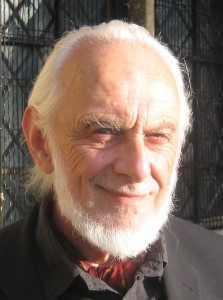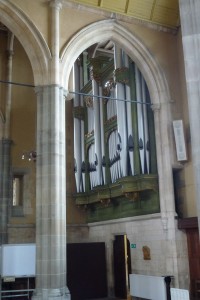Harry Bramma at All Saints, Tooting
 I am Woolf van Silver, a long standing member of the congregation at All Saints, and am running the project to raise and spend money on our Historic Harrison organ: to preserve it physically and to use modern media to record and broadcast its beautiful sounds It is a honour to be involved with such an instrument — and a very great privilege to have Harry as a mainstay to our efforts, and such a virtuoso in demonstrating and explaining its capabilities
I am Woolf van Silver, a long standing member of the congregation at All Saints, and am running the project to raise and spend money on our Historic Harrison organ: to preserve it physically and to use modern media to record and broadcast its beautiful sounds It is a honour to be involved with such an instrument — and a very great privilege to have Harry as a mainstay to our efforts, and such a virtuoso in demonstrating and explaining its capabilities
I am Harry Bramma and have had a long term connection with All Saints – in fact from 1976. The present Organist of the Church – Alun Barlett – has kindly given permission for me to do a short demonstration of the organ for The Southwark and South London Society of Organists website since I am the Honorary President.
I became Organist of Southwark Cathedral in 1976 after twelve and a half years as Assistant Organist at Worcester Cathedral. Since then I have been closely associatated with the diocese of Southwark as an Organ Adviser and a member of the Diocesan Advisory Committee. I have over 40 years gained a great deal of information about South London instruments as a result of this work. On leaving Southwark Cathedral in 1989, I was Director of the Royal School of Church Music for 10 years and Organist of All Saints, Margaret Street, W1 from 1989 to 2004. I now play regularly as an itinerant deputy in South London.
The Organ
The Harrison and Harrison organ at All Saints‘ is an outstanding example of the firm’s work dating from 1907, standing in its fine case by Walter Tapper, later knighted and elected President of the R.I.B.A. in the 20’s.
This notable building by Temple Moore has remarkable acoustics and has been much used as a recording venue.
The organ is particularly significant because tonally it is totally unaltered from the day Arthur Harrison finished work on it. It’s one of a series of organs built between 1904 and 1914 which established Harrison’s as a leading organ builder of the day. It followed Durham cathedral of 1905 and came before Ely Cathedral (1908). All Saints, Margaret Street (1910) and St Mary, Redcliffe, Bristol (1912) were some of a fine collection of instruments dating from the Edwardian era.
The instrument at Tooting is a large three manual with 45 speaking stops. It is really a cathedral organ without the fourth manual.
The tutti of the organ is majestic and very powerful, topped by the Great Trombas, 8 and 4 foot, very fine heavy pressure ranks which have to be used occasionally and with discretion!
Click the photo of All Saints to hear my improvisation in the form of a Gavotte highlighting the louder features of the organ which give the tutti of the Instrument its particular and magnificent personality (3 mins) or use this link: https://www.youtube.com/embed/K8o6cEZdw7Y
 The organ also has a wide rage of softer registers, many of which are to be found on the large Choir organ.
The organ also has a wide rage of softer registers, many of which are to be found on the large Choir organ.
Click the photo of the organ pipes to hear me demonstrating the softer stops and beautiful combinations of them (6 mins), or use this link: https://www.youtube.com/embed/SLvrcF4cL0U
A description of the stops is given on the npor link http://www.npor.org.uk/NPORView.html?RI=N17304
Harry Bramma
Previous My Churches



